Types of Beautiful Moths (With Pictures) – Identification Guide
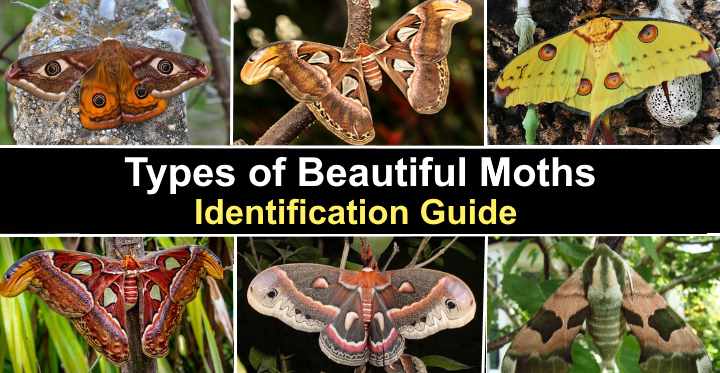
Many species of moths are some of the most beautiful flying insects you can see. Colorful moths can be orange, red, green, yellow, white, and pink. The prettiest moths have intricate, colorful patterns on their wings that create dazzling displays when they flutter around at dusk. In many cases, multi-colored moths can be as beautiful as many species of butterflies.
Many people tend to associate moths as small brown or dull gray winged insects. Also, the common brown moth gets a bad rap and is considered a serious pest due to the damage the larvae do. But many moths can be some of the prettiest insects you will see flying in the wild.
This article is a complete guide to the most spectacular types of beautiful moths. Pictures and descriptions of cool and pretty moths will help you identify moths in a garden or woodland landscape.
How to Identify Beautiful Moths
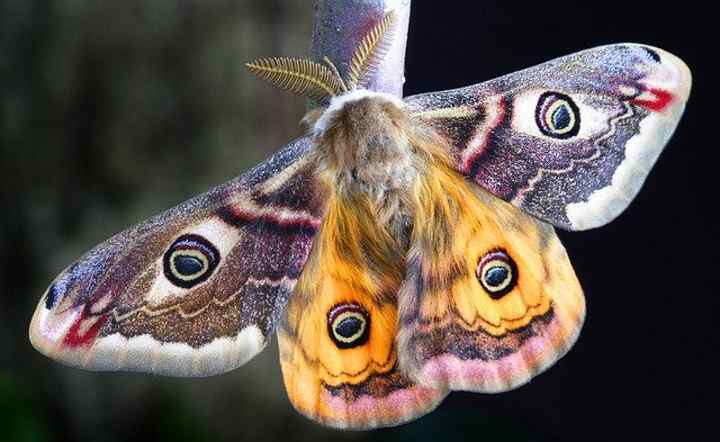
Moths can be identified by their feathery antennae, nocturnal activity and holding their wings parallel to the ground when resting
There are three ways to identify types of moths—by their wings, antennae, and nocturnal activity.
To identify a type of moth, look closely at its antennae. Generally, all moths have feelers with saw-like or tooth-like edges giving the feathery antennae a ragged or fuzzy appearance. Also, moths typically have a furry body and, sometimes, hairy wings.
Next, look at the colorful wings on the beautiful moths. All moths have four wings, and when they are resting, their wings are flat rather than pointed upward like butterflies.
The third way to identify a moth species is by their activity. Unlike butterflies, most moths tend to be active at dusk or during the night. You’ll also find that moths are attracted to light. However, some types of beautiful moths are active during the day.
Facts About Beautiful Moths
Moths are flying insects with four wings belonging to the insect order Lepidoptera. Scientists reckon that there are over 160,000 moth species, and 11,000 are native to North America. Compared to the number of butterfly species, there is ten times the number of moth species globally.
Moths belong to the class of insects in the phylum called Arthropoda. All types of moths have six legs, two antennae, a thorax, and an abdomen. Like butterflies, moths have four wings, and many of them have colorful, delicate patterns.
Colorful, pretty moths can range in size from a wingspan of a few millimeters to 10” (25 cm).
Types of Beautiful Moths — Names, Pictures, and Identification Guide
Let’s look in more detail at identifying some of the most beautiful moths in the world.
Glanycus Coendersi Kalis (Thyrididae striglininae)
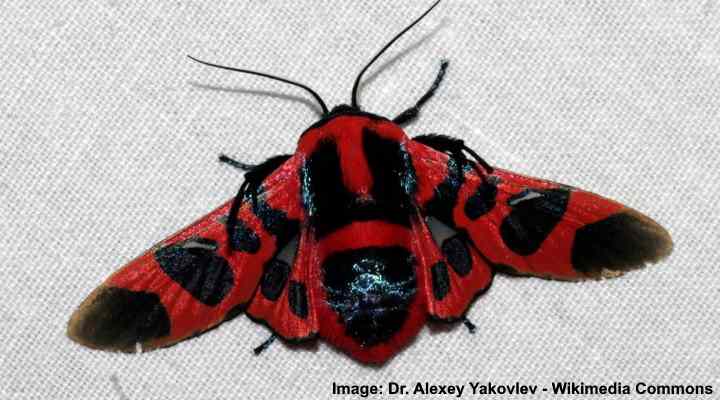
The attractive black and red Glanycus Coendersi Kalis moth has smooth antennae and is active during the day
Glanycus coendersi Kalis is a black and bright red moth in the family of picture-winged moths. This beautiful two-colored moth is found in tropical climates and is active during the day. The Glanycus coendersi Kalis is identified by its long forewings, short hind wings, and plump black and red body.
Pictures of this rare tropical moth show that its two long antennae are relatively smooth. Also, Thyrididae striglininae has identifiable fuzzy black legs. Additionally, the tips of its forewings can be brownish-black in some species.
Glanycus Coendersi Kalis moth identification
Look for vibrant red patches on pitch-black wings, two thin, wiry antennae, and black fuzzy legs on Glanycus Coendersi Kalis moths.
Barsine orientalis
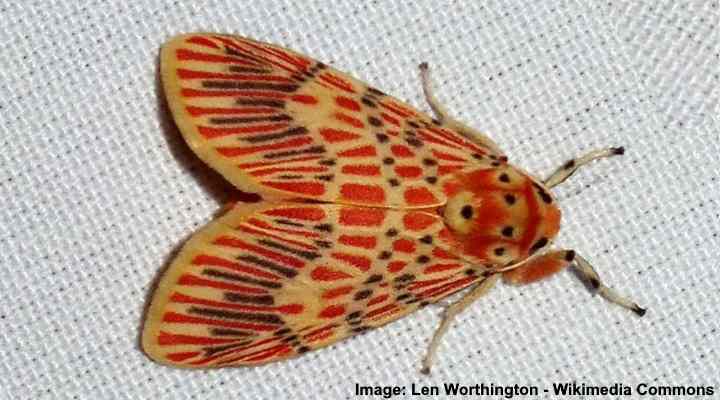
The beautiful Barsine orientalis moth has colorful markings in shades of orange, tan, brown and black
Barsine orientalis is a multi-colored, pretty moth with orange, tan, dark brown, and black markings. Like many types of beautiful moths, this orange moth is native to tropical climates. The patterns on the wings are geometric shapes of squares and rectangles as well as some circles.
When resting, the Barsine orientalis has its large, rounded flat wings, covering its back. You’ll also see that the cool moth has whitish-gray legs with black markings. Finally, the orange moth has narrow white antennae.
Barsine orientalis moth identification
The identifying feature of the Barsine orientalis moth is its pale tan wings with orange squares or rectangles and brown patterns.
Comet Moth (Argema mittrei)
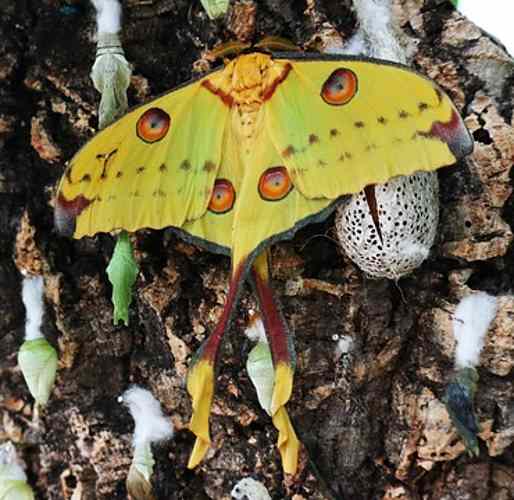
The Comet moth has large green-yellow wings with eye-like markings and very long hind wings
The comet moth is a huge, beautiful moth with identifying large greenish-yellow wings, eye markings, and feathery antennae. The stunning feature of the comet moth is the bright eye markings on each wing. These brown and orange circles stand out on the yellowish wings. In addition, the wings have black margins, black and brown tips, and fuzzy dots in two lines.
Also called the Madagascan moon moth, the comet moth has a wingspan of 8” (20 cm). The hind wings have long tails, making the tropical moth measure up to 6” (16 cm) long. This moth species is one of the largest types of silk moths and is found in Madagascar.
Comet moth identification
The comet moth is identified by its long tails, broad yellowish-green wings, and spectacular eye-like markings.
Common Sheep Moth (Hemileuca eglanterina)
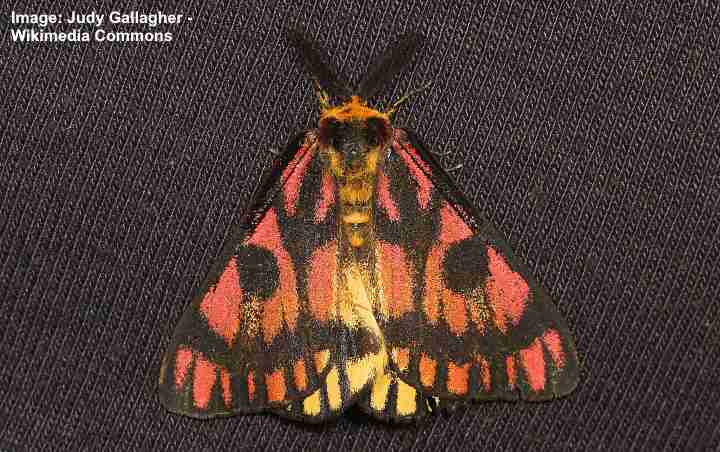
The common sheep moth has orange, pink and yellow wings with decorative black pattern and is active during daytime
The common sheep moth is an eye-catching yellow, pink, orange and black moth, identified by its slender body, feather-like antennae, and large orange wings with black markings. The sheep moth has a wingspan of 2” to 3” (5 – 8 cm). The forewings and hind wings are similar in size.
The identifying feature of the sheep moth is its orange and black forewings and yellow and black hind wings. You’ll also notice pinkish coloring on the forewings. Both sets of wings have a large single black dot, black wavy lines, and a black margin around the pink and yellow wings.
The sheep moth is a North American native silk moth commonly found in California. It’s easy to mistake this species for a butterfly because of its beautiful yellow and black colors and daytime activity.
Sheep moth identification
Sheep moth identification is by its pink and black forewings, yellow and black hind wings, slender body, and feathery antennae.
Joseph’s Coat Moth (Agarista agricola)

Joseph’s coat moth has stunning colorful wings and is active during daytime
One of the coolest colorful moths is the beautiful Joseph’s coat moth. The pitch-black wings have bright markings of bright red, yellow, white and blue. Classed as a medium-sized moth, Joseph’s coat moth is native to Australia and is a daytime moth. However, the stunning moth is as beautiful as many colorful butterflies.
Joseph’s coat moth has colorful black wings with a span of 2.7” (7 cm). To identify the female moths, look for a large white area at the forewings’ base. Additionally, the female moths are larger than the male species.
Before becoming a beautiful moth, Joseph’s coat was a black and white striped caterpillar.
Joseph’s coat moth identification
To identify Joseph’s coat moth, look for the luminous-like blue, red, yellow, and white markings on brown or black wings.
Mariposa Nocturna
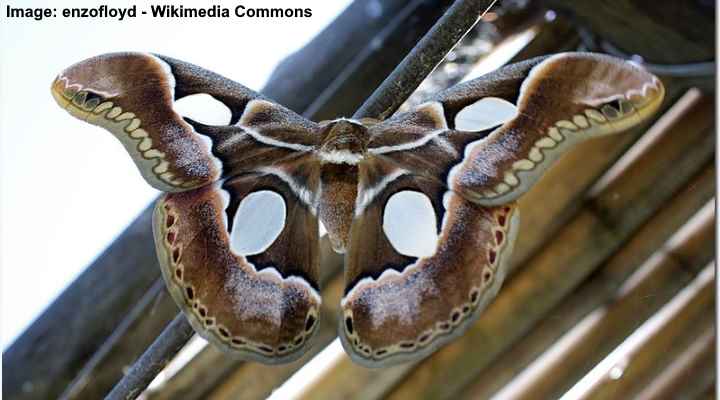
Mariposa nocturna is a large moth with various shades of brown wings with big white spots
Mariposa nocturna is a large brown moth with beautiful white spots, a line of white or brown dots around the edges, and a brown fuzzy body. The eye-catching wings also have patterns in various shades of brown and white stripes. Unfortunately, as one of the prettiest nocturnal moths, it can be challenging to spot this large moth.
Mariposa nocturna moth identification
Mariposa nocturna moths are identified by the large white spot on the brown-patterned wings.
White Flannel Moth (Norape ovina)

The unique looking white flannel moth can be easily recognized by its all-white fuzzy appearance
The flannel moth is one of the most beautiful white moths you will find. The fuzzy, snow-white wings have a shimmering appearance, making this flannel moth easy to identify. You’ll also notice characteristic feathery antennae that are a gold color. White flannel moths have a wingspan of 1” to 1.2” (2.5 – 3 cm).
White flannel moths are native North American furry moths. You’ll find the flannel moths as far south as Texas and Florida and north as far as Washington D.C.
White flannel moth identification
White flannels are easy to identify by their pure white wings and bodies.
Rosy Maple Moth (Dryocampa rubicunda)
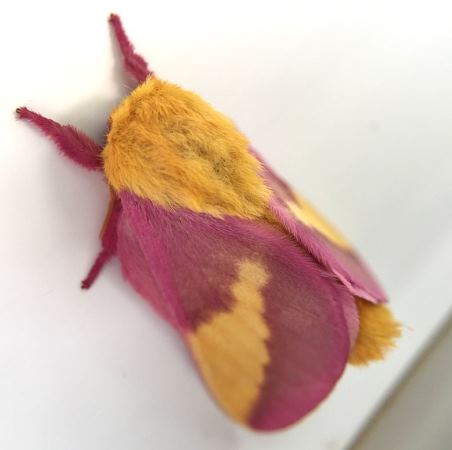
The beautiful fluffy rosy maple moth is easily identified by its colorful yellow and pink wings
The rosy maple moth is one of the coolest moths due to its beautiful brightly colored pink and yellow wings. The furry moths are distinguishable by their pastel yellow and pink colors, short fuzzy feet, and stumpy hairy antennae. The wooly rosy maple moths have a wingspan of up to 2” (5 cm).
Depending on the climate and individual moth, there can be more or less pink coloring on the wings. In Missouri, there is a subspecies of completely white Dryocampa rubicunda moths.
Rosy maple moth identification
Rosy maple moths are identifiable by their wooly bright pink and yellow-colored wings, furry legs, and furry antennae.
Io Moth (Automeris io)
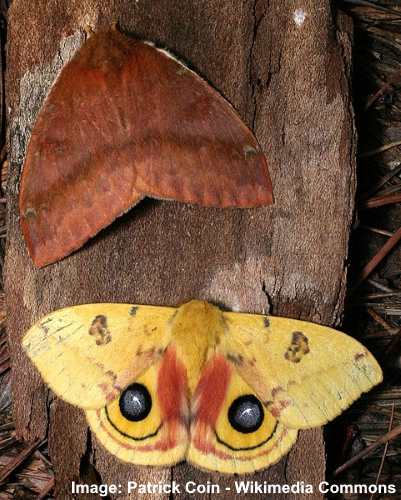
Io Moth (Automeris io): female (top) and male (bottom)
The Io moth is a beautiful yellow moth with distinguishable eye-like markings on the hind wings. The colorful Io moths have triangular wings with patterns and a plump furry body. Io moths have a wingspan of 2.5” to 3.5” (6 – 9 cm). The large bluish-black eyespots on the fuzzy moths are a defense mechanism.
Io moth identification
You can identify male Io moths by their yellow wings and furry body. Female Io moths have pinkish-brown wings. Both species of Io moth are identified by an eyespot and circular markings on each hind wing.
Lime Hawk-Moth (Mimas tiliae)
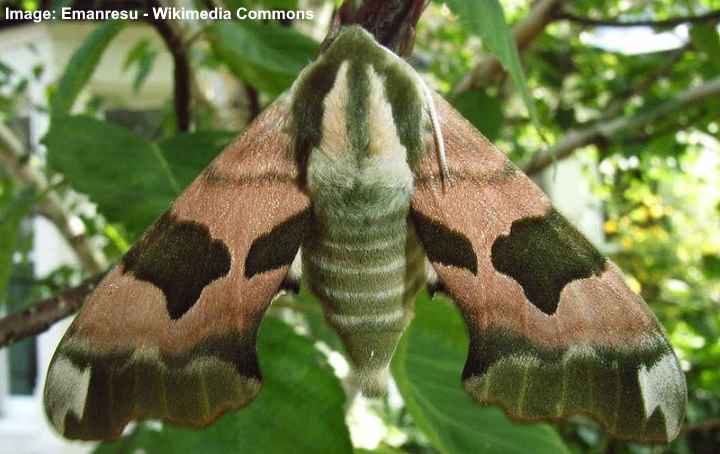
The lime hawk-moth is camouflaged well due to its light brown and dark green patches
The lime hawk-moth is a pretty greenish and brown moth with camouflage-like wing markings. The forewings are identified by pinkish-tan colors that have dark green blotches. The hind wings are an unremarkable brown color. Lime hawk-moths have wingspan of 2.8” – 3” (7 – 8 cm).
Compared to the wings, the lime hawk-moth has a relatively fat green body. You will notice bands around the abdomen, making this hawk-moth easy to identify.
Lime hawk-moth moth identification
Lime hawk-moth identification is by the light brown wings with dark green patches that help camouflage the moth amongst green leafy foliage.
Twin-Spotted Sphinx Moth (Smerinthus jamaicensis)
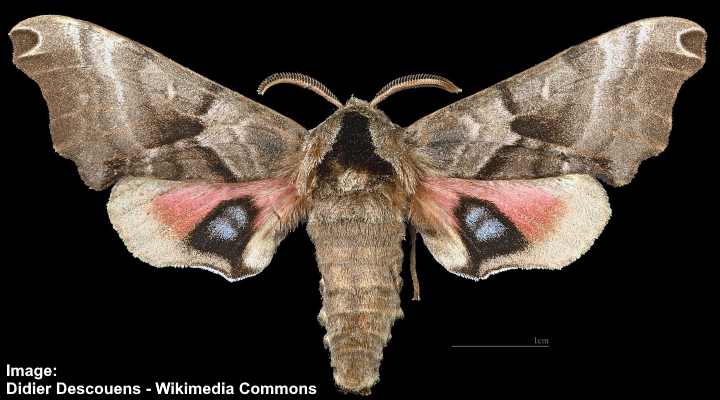
The twin-spotted sphinx moth can be identified by its pink and yellowish hindwings with blue eye markings
The twin-spotted sphinx moth is on the list of beautiful moths due to the delicate reddish-pink coloring on the light brown wings. Some of these sphinx moths develop spectacular eyespots that look like cat’s eyes. Another notable feature is the scalloped edges of the forewings.
Twin-spotted sphinx moths have a sizeable wingspan of 2” – 3” (5 – 8 cm). Twin-spotted sphinx moths are common throughout North America. The nocturnal winged insects become active at dusk.
Twin-spotted sphinx moth identification
The identifying features of the twin-spotted sphinx moths are wedge-shaped forewings with uneven margins, eye-like markings, and pink coloring on brown or tan-colored wings.
Garden Tiger Moth (Arctia caja)
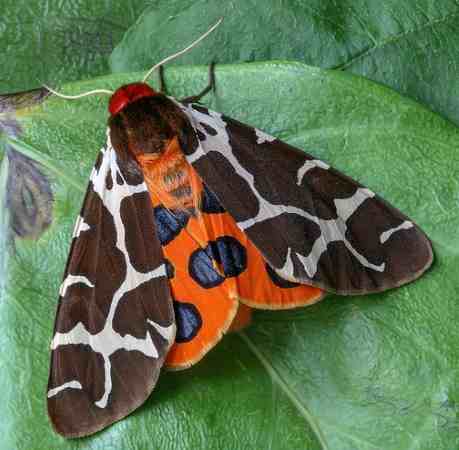
The stunning garden tiger moth has fuzzy body and beautiful coloring and markings on its wings
The garden tiger moth is a beautiful moth with leopard-like brown and creamy white patterns on its forewings. The hindwings of the garden tiger moth are an eye-catching bright orange color with blue and black spots. The garden tiger moth measures 1.8” to 2.6” (4.5 – 6.5 cm) across.
When the garden tiger moth is resting, only the brown and white wings are visible. However, if the moth is disturbed, it will display its orange wings. The unusual moth has a furry orange body with black dots, a brown wooly head, and creamy-white antennae.
Also called the great tiger moth, this medium-sized moth is common in Europe, Canada, and the United States.
Garden tiger moth identification
The garden tiger moth is identifiable by its brown and white forewings and orange hindwings with blue spots. Also, look for the brown furry head and orange body.
Luna moth (Actias luna)
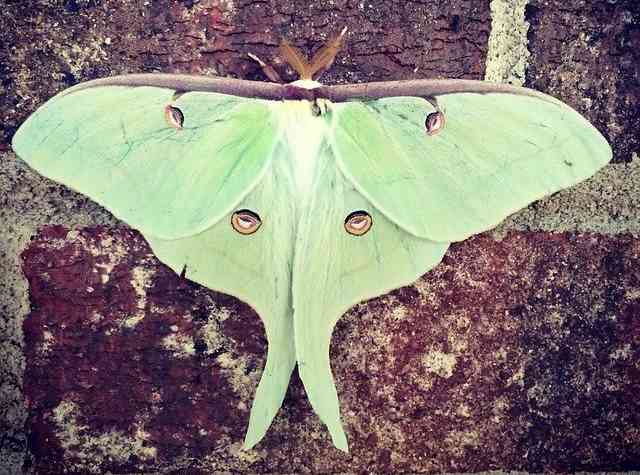
The green luna moth has tail-like hindwings and it looks like a leaf
The luna moth is a large green moth with lime-green wings and elongated tails on the hindwings. The large forewings and hindwings have yellow and brown eyespots, giving the moth a menacing appearance to predators. The luna moth antennae are short and are comb-like on four sides. Luna moths have wingspan of 3” to 4” (7 – 10 cm).
Luna moths can be difficult to spot in the wild. The green wings make the large moth look like a leaf. Also, its short lifespan of 10 days and nocturnal activity mean they are rarely seen
Luna moth identification
The luna moth is distinguishable by its large pale green wings that look like leaves and long tails on the hindwings.
Beautiful Wood Nymph Moth (Eudryas grata)
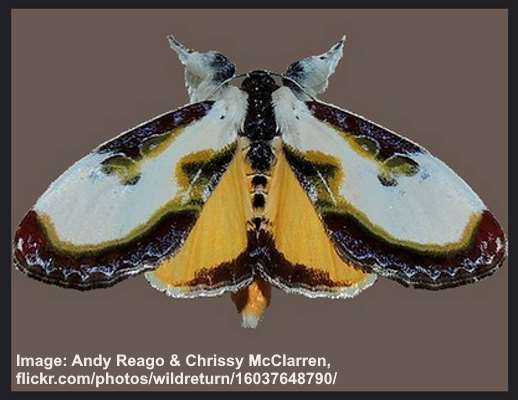
The beautiful wood nymph moth looks like bird dropping with its brown, white and yellow wings
The beautiful wood nymph is a cool-looking moth with white and brown forewings and bright yellow hind wings. The unusual coloring of the wings makes the moth look like bird droppings. When the beautiful wood nymph is resting, the large furry white antennae are clearly visible.
The beautiful wood nymph moth is common throughout the eastern United States. It has a wingspan of 1.3” to 1.7” (3.5 – 4.5 cm).
Beautiful wood nymph moth identification
The identifiable features of the wood nymph moth are its multi-colored white, yellow and brown wings and thick hairy antennae.
Atlas moth (Attacus atlas)
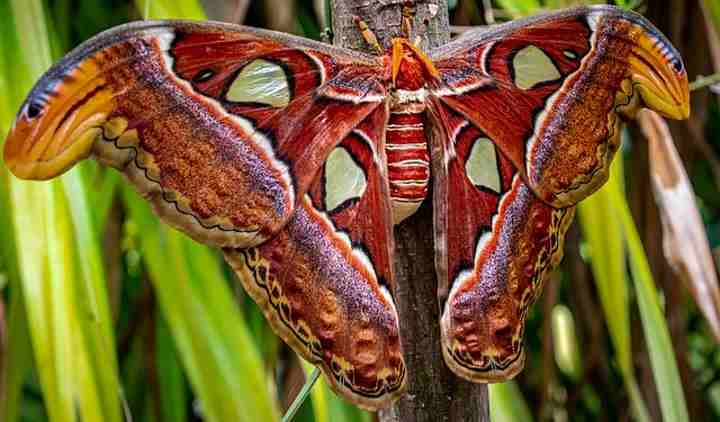
The atlas moth is a magnificent type of large colorful moth with distinctive forewing tips
The atlas moth is one of the most giant and most beautiful moths in the world. The orangey-brown moth has large wings with white triangular spots and patterns of pink, white, black, and purple lines. Close-up pictures of the moth reveal comb-like antennae. Compared to its enormous bright orange patterned wings, the moth has a small body.
The wingspan of the atlas moth measures up to 9.5” (24 cm), which makes it wider than the size of an average adult’s hand.
Atlas moth identification
The size of the atlas moth makes it easy to identify. Look for orangey-brown wings with white and black spots and orange, yellow, purple, and pink-colored patterns.
Cecropia Moth (Hyalophora cecropia)
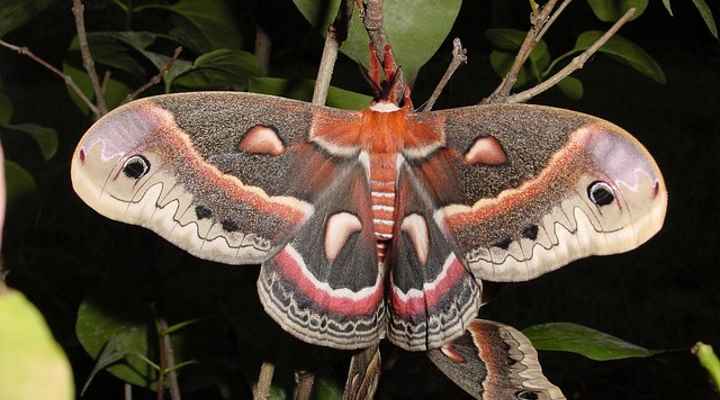
The large and colorful cecropia moth has stunning shades of brown, beige and orange patterns on its wings
The cecropia moth is a giant brown silk moth and is the largest moth in North America. The sizeable orange-brown wings have spots, zig-zag, and lined patterns. The giant moth also has two feathery antennae and a relatively small hairy orange body. Cecropia moths measure 5” and 7” (12 – 18 cm) across.
Cecropia moth identification
Their large brownish wings identify cecropia moths with crescent-shaped orange and white spots, orange-red bands, white coloration, and wavy white and black lines.
Madagascan sunset moth (Chrysiridia rhipheus)
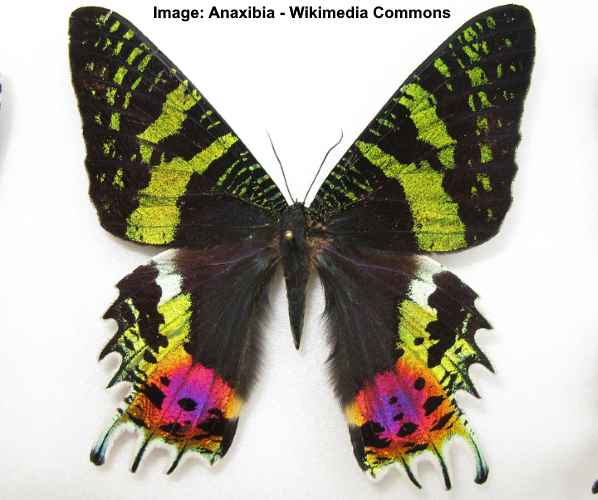
The Madagascan sunset moth has stunning colorful iridescent wings with 3 small tails on its hind wings
The Madagascan sunset moth is one of the most impressive colorful moths you will come across. The identifying feature of the sunset moth is its iridescent green, pink and orange markings on black wings. The dark moth’s wings also have white markings. The moths have a wingspan of 3” to 3.5” (7 – 9 cm).
Madagascan sunset moth identification
You can identify the Madagascan sunset moth by its colorful green, pink, white, and orange markings, as well as three small tails on each hind wing.
Polyphemus moth (Antheraea polyphemus)
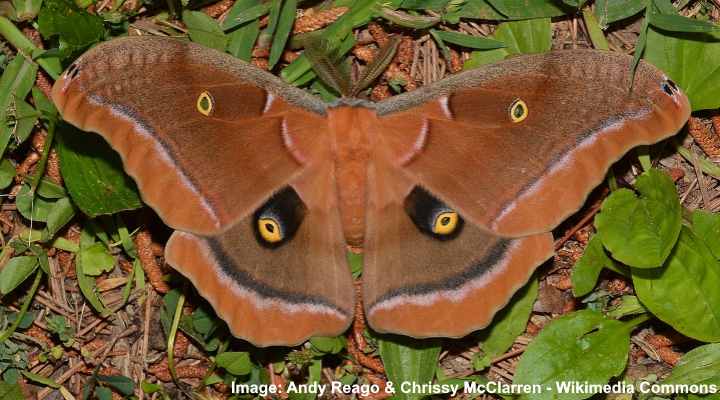
Polyphemus moth is a large furry brown moth with distinct yellow and black eye markings on its wings
The polyphemus moth is a beautiful large brown silk moth with pale pink and blue lines and spectacular eyespots. As one of the largest North American moths, the polyphemus moth has a 6” (15 cm) wingspan. You can find this giant silk moth on beech, maple, birch, willow, and fruit trees in North America.
Polyphemus moth identification
The polyphemus moth is identified by its vast tan wings. The hindwings have yellow and black eyespots, and the forewings have small yellow spots. Brown margins and pale pink wavy lines help with identifying this moth species.
Emperor moth (Saturnia pavonia)
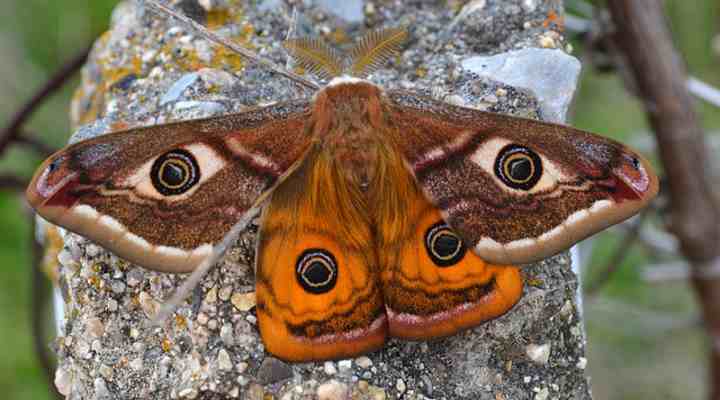
The attractive large emperor moth is active during the day and is characterized by its hairy body and brown and orange wings with eye markings
The beautiful emperor moth is a medium-sized brown fuzzy moth with large eyespots on each wing. The forewings are white and brown, whereas the hindwings are orange and brown with pink margins. A feature of the emperor moth is that it is active during the day, making it easy to spot in woodlands and grasslands.
Emperor moth identification
You can identify the emperor moth by the four spectacular eyespots on the wings. Also, look for white, pink, and brown colored bands on the orange and brown wings.
Japanese silk moth (Antheraea yamamai)
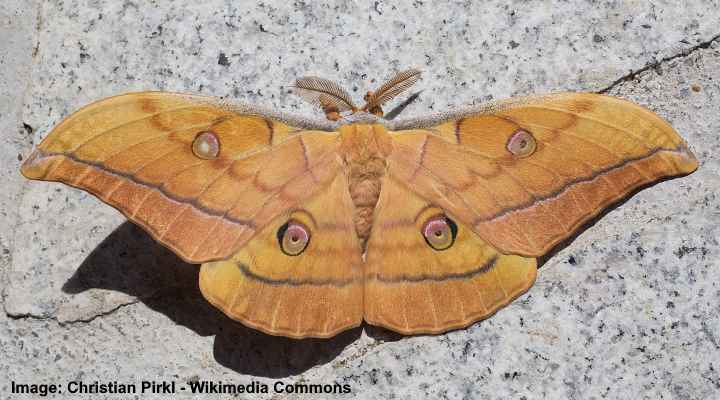
The large and pretty Japanese silk moth has pale orangey-yellow wings with eye-like markings
The Japanese silk moth is a large orange-yellow silk moth with feathery antennae, an eyespot on each wing, and faint brown markings. Japanese silk moths have a wingspan of 4.3” to 6” (11 – 15 cm). As its name suggests, the silk moth is native to Japan, but it has also been hybridized with the polyphemus moth in North America.
Japanese silk moth identification
To identify the Japanese silk moth, look for its pale orange wings with eyespots that have a dot in the middle and comb-like antennae.
Related articles:
- Types of Butterflies with Identification Guide
- Amazing Types of Ladybugs with Pictures
- Black Beetles – Identification
